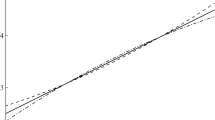Abstract
A melt of a copolymer of 60% hydroxybenzoic acid and 40% ethylene terephthalate was subjected to a uniform magnetic field with B = 0.65 T at 300 °C. The structure and thermal expansion of the material was studied by x-ray diffraction and dilatometry. The magnetic field produced a highly oriented structure. Dilatometry revealed previously unreported relaxation transitions in this material.
Similar content being viewed by others
References
W. J. Jackson and H. F. Kuhfuss, “Liquid crystal polymers. 1. Preparation and properties of p-hydroxybenzoic acid copolyesters,” J. Polymer Sci. Polymer Chem. Ed., 14, No. 8, 2043–2058 (1976).
J. Menczel and B. Wunderlich, “Phase transition in mesophase macromolecules. 1. Novel behavior in the vitrification of poly (ethylene terephthalate-co-p-oxybenzoate),” J. Polym. Sci., Polymer Phys. Ed., 18, No. 6, 1433–1438 (1980).
U. W. Gedde, D. Buerger, and R. H. Boyd, “Dielectric relaxation in liquid crystalline poly(p-hydroxybenzoic acid-co-ethyleneterephthalate),” Macromolecules,29, No. 5, 988–992 (1987).
E. G. Joseph, G. L. Wilkes, and D. G. Baird, “Effect of flow history on the morphology of thermotropic liquid crystalline copolyesters,” Polymer Eng. Sci.,25, No. 7, 377–388 (1985).
T. Shiwaku, A. Nakai, H. Hasegawa, and T. Hashimoto, “Ordered structure of thermotropic liquid-crystal polymers. 1. Characterization of liquid domain texture,” Macromolecules,23, No. 6, 1590–1599 (1990).
V. A. Nicely, J. T. Dougherty, and L. W. Renfro, “Sequence distributions and a phase diagram for copolymers made from poly(ethyleneterephthalate) and p-acetoxybenzoic acid,” Macromolecules,20, No. 573–578 (1987).
C. Viney and A. H. Windle, “Phase transformations in the thermotropic liquid crystal polymer: 60/40 PABA/PET,” J. Materials Sci.,17, No. 9, 2661–2670 (1982).
W. Meesiri, J. Menczel, U. Gaur, and B. Wunderlich, “Phase transition in mesophase molecules. III. The transitions in poly(ethylene terephthalate-co-p-oxybenzoate),” J. Polymer Sci., Polymer Phys. Ed.,20, No. 4, 719–728 (1982).
D. Acierno, F. P. La Mantia, and G. Polizzotti, “Ultrahigh modulus liquid crystalline polyesters. p-Hydroxybenzoic acid copolyesters,” Macromolecules,15, No. 6, 1455–1459 (1982).
M. Kimura and R. S. Porter, “Compatibility of poly(butylene terephthalate) with a liquid-crystalline copolyester,” J. Polymer Sci., Polymer Phys. Ed.,22, No. 9, 1697–1699 (1984).
H. Sugiyama, D. N. Lewis, J. L. White, and J. F. Fellers, “Structural characteristics, rheological properties, extrusion, and melt spinning of 60/40 poly(hydroxybenzoic acid-co-ethylene terephthalate) (PHB/PET),” J. Appl. Polymer Sci.,30, No. 6, 2329–2341 (1985).
H. Muramatsu and W. R. Krigbaum, “Fiber spinning from the nematic melt. I. Copolyester of poly(ethylene terephthalate) and p-oxybenzoate,” J. Polymer Sci., Polymer Phys. Ed.,24, No. 8, 1695–1711 (1986).
H. Muramatsu and W. R. Krigbaum, “Fiber spinning from the nematic melt. II. Effect of thermal history on spinning of the copolyester of polyethylene terephthalate and p-oxybenzoate,” J. Polymer Sci., Polymer Phys. Ed.,25, No. 4, 803–816 (1987).
J. A. Cuculo and G.-Y. Chen, “Extrusion fiber formation and characterization of thermotropic polyesters,” J. Polymer Sci., Polymer Phys. Ed.,26, No. 1, 179–200 (1988).
W. Brostow and T. S. Dziemianowicz, “Transmission of mechanical energy through polymeric liquid crystals and their blends,” Polymer Eng. Sci.,28, No. 12, 785–795 (1988).
P. Zhuang, T. Kyn, and J. L. White, “Characteristics of hydroxybenzoic acid-ethyleneterephthalate copolymers and their blends with polystyrene and polyethylene terephthalate,” Polymer Eng. Sci.,28, No. 17, 1095–1107 (1988).
H. J. Lader and W. R. Krigbaum, “Thermal behavior of co[poly(ethylene terephthalate)-p-oxybenzoate],” J. Polymer Sci., Polymer Phys. Ed.,17, No. 10, 1661–1674 (1974).
R. E. Jerman and D. G. Baird, “Rheological properties of copolyester liquid crystalline melts. 1. Capillary rheometry,” J. Rheol.,25, No. 2, 275–292 (1981).
A. T. Dibenedetto, “The effect of hot drawing on the properties of thermotropic polymer fibers,” Polymer Eng. Sci.,29, No. 3, 153–162 (1989).
G. R. Mitchell and A. H. Windle, “Measurement of molecular orientation in thermotropic liquid crystalline polymers,” Polymer,24, No. 12, 1513–1520 (1983).
Y. Takeuchi, F. Yamamoto, and Y. Shuto, “Intrinsic values of the linear expansion coefficient for nematic poly(ethylene terephthalate)/p-oxybenzoate copolyesters,” Macromolecules,19, No. 7, 2059–2061 (1986).
D. Done and D. G. Baird, “The effect of thermal history on the rheology and texture of thermotropic liquid crystalline polymers,” Polymer Eng. Sci.,27, No. 11, 816–822 (1987).
J. Blackwell, G. Lieser, and G. A. Gutirrez, “Structure of p-hydroxybenzoate/ethylene terephthalate copolyester fibers,” Macromolecules,16, No. 9, 1418–1422 (1983).
Ya. G. Dorfman, Diamagnetism and the Chemical Bond [in Russian], Moscow (1961).
R. D. Maksimov and T. Stezhinski, “Mechanical properties of mixed composites from a liquid-crystalline copolyester and polypropylene,” Mekhan. Kompozitn. Mater.,30, No. 4, 442–450 (1994).
V. V. Tsukruk, V. V. Shilov, and D. Ienikhen, “Structural characteristics of highly oriented fibers from polyethylene terephthalate-hydroxybenzoic acid copolymers obtained from a liquid crystalline melt,” Vysokomolek. Soedin. Ser. A,30, No. 10, 2202–2207 (1988).
M. A. Martynov and K. A. Vylegzhanina, X-Ray Diffraction of Polymers [in Russian], Khimiya, Leningrad (1972).
V. A. Bershtein and V. M. Egorov, Differential Scanning Calorimetry in the Physical Chemistry of Polymers [in Russian], Khimiya, Leningrad (1990).
Yu. K. Godovskii, Thermophysics of Polymers [in Russian], Khimiya, Moscow (1982).
G. M. Bartenev and S. Ya. Frenkel', Polymer Physics [in Russian], Khimiya, Leningrad (1990).
Author information
Authors and Affiliations
Additional information
Translated from Mekhanika Kompozitnykh Materialov, Vol. 31, No. 2, pp. 269–281, March–April, 1995.
Rights and permissions
About this article
Cite this article
Korkhov, V.P., Faitel'son, E.A. Effect of force fields on a thermotropic liquid-crystalline copolymer of hydroxybenzoic acid and ethylene terephthalate. 1. Creation of oriented copolymer structure in a uniform magnetic field. Mech Compos Mater 31, 196–204 (1995). https://doi.org/10.1007/BF00616289
Received:
Issue Date:
DOI: https://doi.org/10.1007/BF00616289




